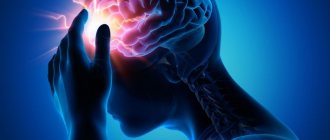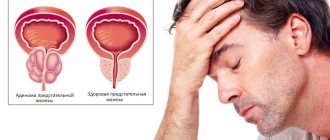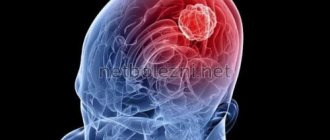The hypothalamus is an important part of the brain. The higher vegetative center carries out complex control and regulation of many body systems. A good emotional state, a balance between the processes of excitation and inhibition, timely transmission of nerve impulses are a consequence of the correct functioning of an important element.
Damage to the structure of the diencephalon negatively affects the functioning of the cardiovascular, respiratory, endocrine systems, and the general condition of a person.
It is interesting and useful to know what the hypothalamus is and what it is responsible for. The article contains a lot of information about the structure, functions, diseases of important structures, signs of pathological changes, and modern methods of treatment.
What kind of organ is this
The diencephalon section influences the stability of the internal environment, ensures the interaction and optimal combination of individual systems with the holistic functioning of the body. An important structure produces a complex of hormones of three subclasses.
Neurosecretory and nerve conduction cells are the basis of an important element of the diencephalon. Organic pathologies in combination with damage to functions disrupt the periodicity of many processes in the body.
The hypothalamus has extensive connections with other brain structures and continuously interacts with the cerebral cortex and subcortex, which ensures an optimal psycho-emotional state. Decortication provokes the development of imaginary rage syndrome.
Infection, tumor process, congenital anomalies, injuries to an important part of the brain negatively affect neurohumoral regulation, interfere with the transmission of impulses from the heart, lungs, digestive organs, and other elements of the body. Destruction of various lobes of the hypothalamus disrupts sleep, metabolic processes, provokes the development of epilepsy, diabetes insipidus, obesity, decreased temperature, and emotional disorders.
Not everyone knows where the hypothalamus is located. The diencephalon element is located under the hypothalamic sulcus, below the thalamus. The cellular groups of the structure smoothly transform into a transparent septum. The structure of the small organ is complex; it is formed from 32 pairs of hypothalamic nuclei, consisting of nerve cells.
The hypothalamus consists of three regions, with no clear boundary between them. The branches of the arterial circle ensure a complete supply of blood to an important part of the brain. A specific feature of the vessels of this element is the ability of protein molecules, even large ones, to penetrate through the walls.
Which organs are affected?
Liberins and statins produced by the hypothalamus reach the pituitary gland through the portal vascular system, where they stimulate the biosynthesis of tropic pituitary hormones. The latter reach the target organs with the blood flow and exert their effect on them.
Let's look at this process in a simplified and schematic way.
Releasing factors reach the pituitary gland through the portal vessels. Neurophysin stimulates the cells of the posterior pituitary gland, thereby increasing the release of oxytocin and vasopressin.
The remaining releasing factors act on the anterior pituitary gland. The diagram of their influence is presented in the table:
| Release factor | A tropic hormone produced by the pituitary gland | Target organ |
| Corticoliberin | Adrenocorticotropin | Adrenal glands |
| Thyroliberin | Thyrotropin | Thyroid |
| Somatoliberin | Somatotropin | Growing tissues and organs |
| Prolactoliberin | Prolactin | Breast |
| Follyliberin | Follicle stimulating hormone | Ovaries, uterus, prostate, seminal vesicles |
| Luliberin | Luteinizing hormone | Ovaries, uterus |
What is he responsible for?
Functions of the hypothalamus in the body:
- controls the functioning of the respiratory , digestion, heart, blood vessels, thermoregulation,
- maintains the optimal state of the endocrine and excretory systems,
- affects the functioning of the gonads, ovaries, pituitary gland, adrenal glands, pancreas and thyroid gland,
- responsible for human emotional behavior
- participates in the process of regulating wakefulness and sleep, produces the hormone melatonin, the deficiency of which develops insomnia and deteriorates the quality of sleep,
- Provides optimal body temperature. With pathological changes in the posterior part of the hypothalamus, the destruction of this zone, the temperature decreases, weakness develops, and metabolic processes proceed more slowly. Often there is a sudden rise in subfertile temperature,
- affects the transmission of nerve impulses,
- produces a complex of hormones, without a sufficient amount of which the proper functioning of the body is impossible.
The table below lists many of these functions and the core groups that are most closely associated with their performance.
| Core | Zone(s) | Region(s) | Functions |
| Paraventricular | Periventricular, Medial | Front, tubular | Fluid balance, decreased milk supply, labor, autonomic control, and anterior pituitary control |
| Preoptic | Medial, Lateral | Front | Lateral anterior thermoregulation, sexual behavior |
| Front | Medial | Front | Lateral anterior thermoregulation, sexual behavior |
| Suprachiasmatic | Medial | Front | Biological rhythms |
| Supraoptic | Medial, Lateral | Front | Fluid balance, milk let-down, labor |
| Dorsomedial | Medial | A tube | Emotion (rage) |
| Ventromedial | Medial | A tube | Appetite, body weight, insulin regulation |
| Arc-shaped | Periventricular, Medial | A tube | Control of the anterior pituitary gland, feeding |
| Rear | Medial | Rear | Thermoregulation |
| Mammillary | Medial | Rear | Emotions and short-term memory |
| Lateral complex | Side | A tube | Controlling appetite and body weight |
Hypothalamic diseases
Hypothalamic diseases are disorders that are primarily damage to the hypothalamus caused by malnutrition, including anorexia, bulimia, genetic disorders, radiation exposure, neurosurgery, head trauma, tumors, or other physical damage to the hypothalamus. The hypothalamus is the control center for several endocrine functions. The endocrine systems controlled by the hypothalamus are regulated by anti-diuretic hormone (ADH), corticotropin-releasing factor, gonadotropin-releasing hormone, somatotropin-releasing hormone, oxytocin, all of which are secreted by the hypothalamus. Damage to the hypothalamus can affect any of these hormones and their associated endocrine systems. Many of these hypothalamic hormones act on the pituitary gland. Thus, hypothalamic disease affects the functioning of the pituitary gland and the target organs controlled by the pituitary gland, including the adrenal glands, ovaries and testes, and the thyroid gland.
Damage to the hypothalamus can cause problems regulating body temperature, height, weight, sodium and water balance, milk production, emotions, and sleep cycles. Hypopituitarism, neurogenic diabetes insipidus, tertiary hypothyroidism, and developmental disorders are examples of hypothalamic diseases.
The hypothalamus and pituitary gland are closely integrated with each other. Damage to the hypothalamus affects the normal functioning of the pituitary gland. Hypothalamic disease can result in insufficient or suppressed signaling to the pituitary gland, resulting in a deficiency of one or more of the following hormones: thyroid-stimulating hormone, adrenocorticotropic hormone, beta-endorphin, luteinizing hormone, follicle-stimulating hormone, and melanocyte-stimulating hormones. Treatment of hypopituitarism includes hormone replacement therapy. Neurogenic diabetes insipidus may occur due to low levels of ADH from the hypothalamus. Insufficient ADH levels lead to increased thirst and urine output, and prolonged excessive urine excretion increases the risk of dehydration.
The thyroid gland is an auxiliary organ of the hypothalamic-pituitary system. Thyrotropin-releasing hormone (TRH), produced by the hypothalamus, signals the pituitary gland to release thyroid-stimulating hormone (TSH), which then stimulates the thyroid gland to secrete the thyroid hormones T4 and T3. Secondary hypothyroidism occurs when the secretion of TSH from the pituitary gland is impaired, whereas tertiary hypothyroidism is a deficiency or inhibition of TRH.
Thyroid hormones are responsible for metabolic activity. Insufficient production of thyroid hormones leads to suppressed metabolic activity and weight gain. Thus, hypothalamic disease may have implications for obesity.
Growth hormone-releasing hormone (GHRH) is another releasing factor secreted by the hypothalamus. GHRH stimulates the pituitary gland to secrete growth hormone (GH), which has various effects on body growth and sexual development. Insufficient GH production can lead to poor physical growth, precocious puberty or gonadotropin deficiency, failure to initiate or complete puberty and is often associated with rapid weight gain, low T4 and low sex hormone levels
Causes of problems
Damage to the structural elements of the hypothalamus is a consequence of the influence of several factors:
- traumatic brain injuries,
- bacterial, viral infections: lymphogranulomatosis, syphilis, basal meningitis, leukemia, sarcoidosis,
- tumor process,
- dysfunction of the endocrine glands,
- intoxication of the body,
- inflammatory processes of various kinds,
- vascular pathologies affecting the volume and rate of supply of nutrients and oxygen to the cells of the hypothalamus,
- disruption of physiological processes,
- violation of the permeability of the vascular wall due to the penetration of infectious agents.
Diseases
Negative processes occur against the background of direct dysfunction of an important structure. The tumor process in most cases is benign, but under the influence of negative factors cell malignancy often occurs.
Note! Treatment of hypothalamic lesions requires an integrated approach; therapy is associated with many risks and difficulties.
If oncological pathologies are detected, the neurosurgeon removes the tumor, then the patient undergoes chemotherapy and radiation therapy sessions. To stabilize the functioning of the problem department, a complex of medications is prescribed.
The main types of hypothalamic tumors are:
- teratomas,
- meningiomas,
- craniopharyngiomas,
- gliomas,
- adenomas (grow from the pituitary gland),
- pinealomas.
Symptoms
Impaired functioning of the hypothalamus provokes a complex of negative symptoms:
- eating disorders, uncontrolled appetite, sudden weight loss or severe obesity,
- tachycardia, fluctuations in blood pressure, pain in the sternum, arrhythmia,
- decreased libido, absence of menstruation,
- early puberty due to a dangerous hamartoma tumor,
- headaches, severe aggression, uncontrollable crying or fits of laughter, seizures,
- pronounced causeless aggression, fits of rage,
- hypothalamic epilepsy with a high frequency of seizures throughout the day,
- belching, diarrhea, pain in the epigastric region and abdomen,
- muscle weakness, the patient has difficulty standing and walking,
- neuropsychiatric disorders: hallucinations, psychoses, anxiety, depression, hypochondria, mood swings,
- severe headaches due to increased intracranial pressure,
- sleep disturbance, waking up several times during the night, fatigue, weakness, headaches in the morning. The reason is a lack of the important hormone melatonin. To eliminate the disturbances, you need to adjust your waking and night sleep patterns, and take a course of medications to restore the volume of an important regulator. A good therapeutic effect is provided by the drug Melaxen, a new generation drug with a minimum of side effects, without addiction syndrome,
- blurred vision, poor memory of new information,
- a sharp rise in temperature or decrease in indicators. When temperatures rise, it is often difficult to understand what is causing the negative changes. Damage to the hypothalamus can be suspected by a set of signs indicating damage to the endocrine system: uncontrolled hunger, thirst, obesity, increased urine output.
Diagnostics
Symptoms of damage to the hypothalamus are so varied that several diagnostic procedures need to be performed. Highly informative methods: ultrasound, ECG, MRI. Be sure to examine the adrenal glands, thyroid gland, abdominal organs, ovaries, brain, and vasculature.
It is important to take blood and urine tests, check the levels of glucose, ESR, urea, leukocytes, and hormone levels. The patient visits an endocrinologist, urologist, gynecologist, ophthalmologist, endocrinologist, neurologist. If a tumor is detected, you will need to consult a specialist from the neurosurgery department.
Pituitary gland diseases:
Pituitary diseases are a large group of diseases that can be caused by the presence of a tumor of the pituitary gland or nearby structures, vascular pathology and inflammatory diseases, including granulomatous diseases.
Ultimately, this can lead to hypofunction, hyperfunction of the pituitary gland, and sometimes to mass effect.
Mass effect:
The mass effect of a large pituitary tumor causes blurred vision (due to compression of the optic chiasm) and headaches. If visual field impairment due to a pituitary tumor is suspected, consultation with an ophthalmologist . To diagnose the presence of a formation, MRI of the chiasmal-sellar region with contrast is used.
Hyperfunction of the pituitary gland:
Symptoms of pituitary hyperfunction are varied. Excess prolactin in women often causes lactorrhea, infertility and amenorrhea, and in men it can cause hypogonadism (decreased sexual function). An excess of somatotropic hormone causes gigantism in children, and characteristic changes in appearance (acromegaly) and organomegaly in adults. With an excess of adrenocorticotropic hormone (Cushing's disease), symptoms such as obesity with typical redistribution of fatty tissue on the arms and face, arterial hypertension, diabetes mellitus, and osteoporosis are described.
Hypofunction of the pituitary gland:
With hypofunction of the pituitary gland, hypogonadism develops (decreased sexual function), secondary adrenal insufficiency (low blood pressure, weight loss, decreased glucose levels), secondary hypothyroidism - decreased thyroid function (brittle hair and nails, drowsiness, swelling). Children may also experience delayed growth and sexual development.
Treatment
The treatment regimen for hypothalamic lesions includes several areas:
- correction of the daily routine to stabilize the production of melatonin, eliminating the causes of excessive agitation, nervous tension or apathy,
- changing the diet to supply the optimal amount of vitamins, minerals that normalize the state of the nervous system and blood vessels,
- carrying out drug treatment in identifying inflammatory processes with infection with damage to parts of the brain (antibiotics, glucocorticosteroids , antiviral drugs, restorative compounds, vitamins, NSAIDs),
- receiving sedatives, tranquilizers,
- surgical treatment to remove malignant and benign tumors. For brain cancer pathologies, irradiation is carried out, chemotherapy, immunomodulators are prescribed,
- Diet, injections of vitamins that regulate nervous activity (B1 and B12), and drugs that suppress uncontrollable appetite have a good effect in the treatment of eating disorders.
It is important to know why damage to the hypothalamus can lead to a rapid imbalance of physiological processes in the body.
If pathologies of this part of the brain are identified, you need to undergo a comprehensive examination and consult several doctors. With timely initiation of therapy, the prognosis is favorable. Special responsibility is needed when confirming the development of a tumor process: certain types of neoplasms consist of atypical cells.
Learn more about what the hypothalamus is and what this important organ is responsible for after watching the video:
Diagnosis and treatment:
Pituitary gland disease can be suspected at an appointment with an endocrinologist during a detailed questioning and examination of the patient, after which, if necessary, hormonal and instrumental examinations are prescribed. Often, the primary diagnosis of pituitary diseases is carried out by the level of the hormone at the peripheral level (for example, if Cushing's disease is suspected, excess cortisol, an adrenal hormone, is excluded). It is worth noting that when studying the levels of many hormones (prolactin, cortisol, ACTH, etc.), certain rules must be followed, since the values of these hormones change significantly depending on the time of day, the menstrual cycle and other conditions. For further diagnosis, functional tests may be required (for example, a test with dexamethasone when diagnosing Cushing's disease).
Depending on the specifics of the disease, the patient may be offered surgical treatment (for example, for a pituitary tumor). However, it is worth knowing that prolactinoma is one of the few tumors that can be treated conservatively (with the help of medications). If a hormone deficiency is detected, hormone replacement therapy may be prescribed.








